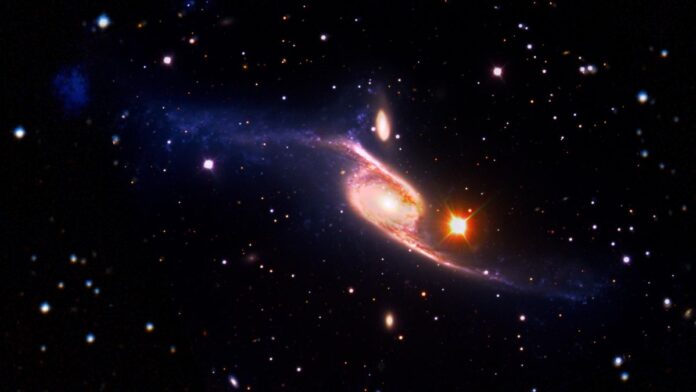Just looking at a single image of NGC 6872, you can’t help but be impressed.
The barred spiral galaxy appears to be quite different than our own Milky Way, with two long tendrils of stars emanating from opposite ends of the structure. It’s as if invisible giants are playing tug of war with a spiral galaxy.
But what makes NGC 6872 truly impressive is its extraordinary size — it’s the largest spiral galaxy we’ve discovered to date. From end to end, the galaxy stretches 522,000 light-years across, which makes it more than five times larger than the Milky Way.
A newly released image shows the galaxy in its entirety, combining visible light images, far-ultraviolet data, and infrared data from the European Southern Observatory’s Very Large Telescope, NASA’s now-decommissioned Galaxy Evolution Explorer (GALEX), and NASA’s now-decommissioned Spitzer Space Telescope, respectively.
NGC 6872, which is located some 212 million light-years away from Earth, is suspected to have such an elongated shape due to its gravitational interactions with the nearby disk galaxy IC4970, which harbors just one-fifth the mass of its bigger neighbor.
These gravitational interactions usually result in a galactic merger. But in this specific case, according to an analysis of the data used to create the new composite image, astronomers suspect that the interaction between the two galaxies is actually producing a new galaxy.
“Understanding the structure and dynamics of nearby interacting systems like this one brings us a step closer to placing these events into their proper cosmological context, paving the way to decoding what we find in younger, more distant systems,” Eli Dwek, an astrophysicist at NASA’s Goddard Space Flight Center in Greenbelt, Maryland, said in a 2013 statement (opens in new tab) announcing NGC 6872 as the largest spiral galaxy we’ve ever seen.
Now, we just have one question. When is the James Webb Space Telescope going to take a look at this galactic behemoth?
Follow Stefanie Waldek on Twitter @StefanieWaldek (opens in new tab). Follow us on Twitter @Spacedotcom (opens in new tab) and on Facebook (opens in new tab).

